The Intel Core i9-9990XE Review: All 14 Cores at 5.0 GHz
by Dr. Ian Cutress on October 28, 2019 10:00 AM ESTCPU Performance: Web and Legacy Tests
While more the focus of low-end and small form factor systems, web-based benchmarks are notoriously difficult to standardize. Modern web browsers are frequently updated, with no recourse to disable those updates, and as such there is difficulty in keeping a common platform. The fast paced nature of browser development means that version numbers (and performance) can change from week to week. Despite this, web tests are often a good measure of user experience: a lot of what most office work is today revolves around web applications, particularly email and office apps, but also interfaces and development environments. Our web tests include some of the industry standard tests, as well as a few popular but older tests.
We have also included our legacy benchmarks in this section, representing a stack of older code for popular benchmarks.
All of our benchmark results can also be found in our benchmark engine, Bench.
WebXPRT 3: Modern Real-World Web Tasks, including AI
The company behind the XPRT test suites, Principled Technologies, has recently released the latest web-test, and rather than attach a year to the name have just called it ‘3’. This latest test (as we started the suite) has built upon and developed the ethos of previous tests: user interaction, office compute, graph generation, list sorting, HTML5, image manipulation, and even goes as far as some AI testing.
For our benchmark, we run the standard test which goes through the benchmark list seven times and provides a final result. We run this standard test four times, and take an average.
Users can access the WebXPRT test at http://principledtechnologies.com/benchmarkxprt/webxprt/
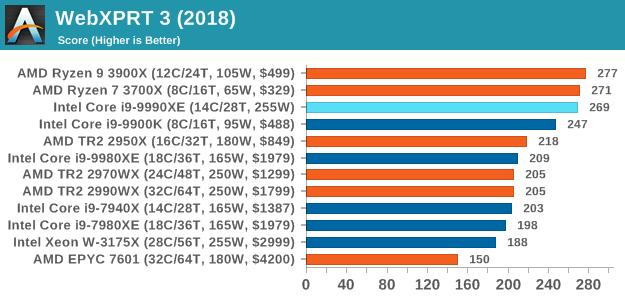
WebXPRT 2015: HTML5 and Javascript Web UX Testing
The older version of WebXPRT is the 2015 edition, which focuses on a slightly different set of web technologies and frameworks that are in use today. This is still a relevant test, especially for users interacting with not-the-latest web applications in the market, of which there are a lot. Web framework development is often very quick but with high turnover, meaning that frameworks are quickly developed, built-upon, used, and then developers move on to the next, and adjusting an application to a new framework is a difficult arduous task, especially with rapid development cycles. This leaves a lot of applications as ‘fixed-in-time’, and relevant to user experience for many years.
Similar to WebXPRT3, the main benchmark is a sectional run repeated seven times, with a final score. We repeat the whole thing four times, and average those final scores.
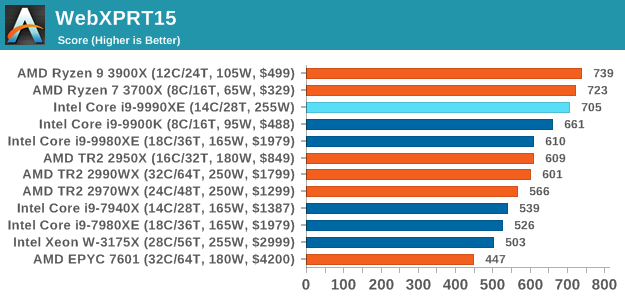
Speedometer 2: JavaScript Frameworks
Our newest web test is Speedometer 2, which is a accrued test over a series of javascript frameworks to do three simple things: built a list, enable each item in the list, and remove the list. All the frameworks implement the same visual cues, but obviously apply them from different coding angles.
Our test goes through the list of frameworks, and produces a final score indicative of ‘rpm’, one of the benchmarks internal metrics. We report this final score.
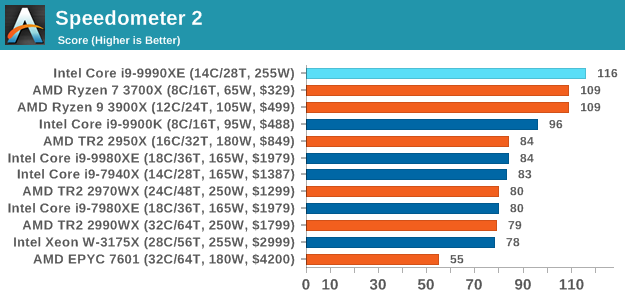
Google Octane 2.0: Core Web Compute
A popular web test for several years, but now no longer being updated, is Octane, developed by Google. Version 2.0 of the test performs the best part of two-dozen compute related tasks, such as regular expressions, cryptography, ray tracing, emulation, and Navier-Stokes physics calculations.
The test gives each sub-test a score and produces a geometric mean of the set as a final result. We run the full benchmark four times, and average the final results.
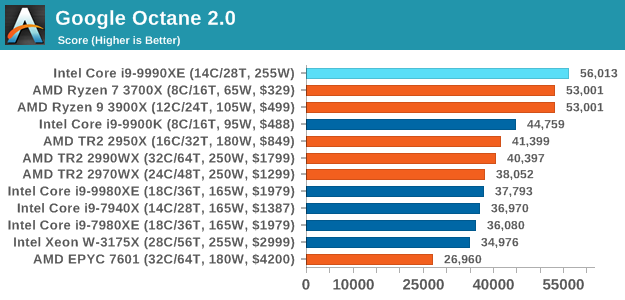
Mozilla Kraken 1.1: Core Web Compute
Even older than Octane is Kraken, this time developed by Mozilla. This is an older test that does similar computational mechanics, such as audio processing or image filtering. Kraken seems to produce a highly variable result depending on the browser version, as it is a test that is keenly optimized for.
The main benchmark runs through each of the sub-tests ten times and produces an average time to completion for each loop, given in milliseconds. We run the full benchmark four times and take an average of the time taken.
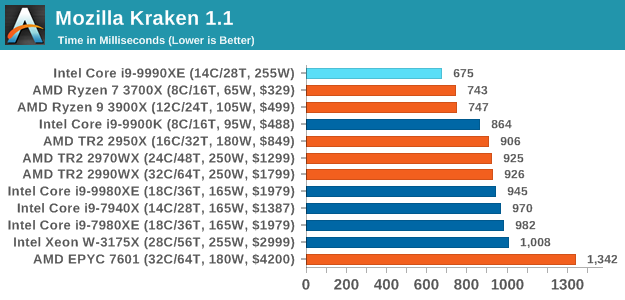
3DPM v1: Naïve Code Variant of 3DPM v2.1
The first legacy test in the suite is the first version of our 3DPM benchmark. This is the ultimate naïve version of the code, as if it was written by scientist with no knowledge of how computer hardware, compilers, or optimization works (which in fact, it was at the start). This represents a large body of scientific simulation out in the wild, where getting the answer is more important than it being fast (getting a result in 4 days is acceptable if it’s correct, rather than sending someone away for a year to learn to code and getting the result in 5 minutes).
In this version, the only real optimization was in the compiler flags (-O2, -fp:fast), compiling it in release mode, and enabling OpenMP in the main compute loops. The loops were not configured for function size, and one of the key slowdowns is false sharing in the cache. It also has long dependency chains based on the random number generation, which leads to relatively poor performance on specific compute microarchitectures.
3DPM v1 can be downloaded with our 3DPM v2 code here: 3DPMv2.1.rar (13.0 MB)
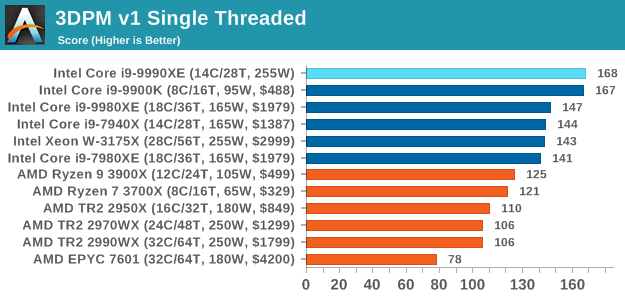
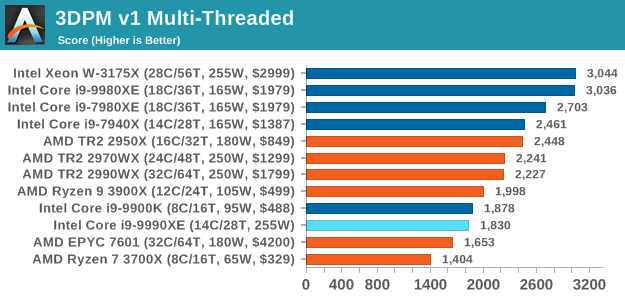
x264 HD 3.0: Older Transcode Test
This transcoding test is super old, and was used by Anand back in the day of Pentium 4 and Athlon II processors. Here a standardized 720p video is transcoded with a two-pass conversion, with the benchmark showing the frames-per-second of each pass. This benchmark is single-threaded, and between some micro-architectures we seem to actually hit an instructions-per-clock wall.
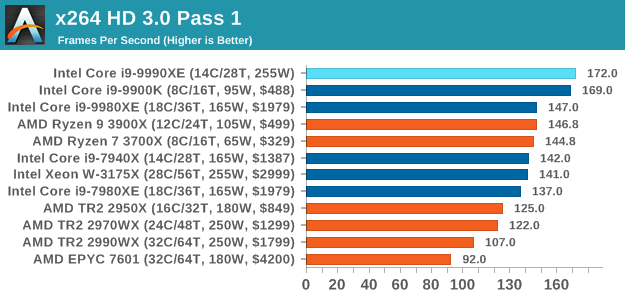
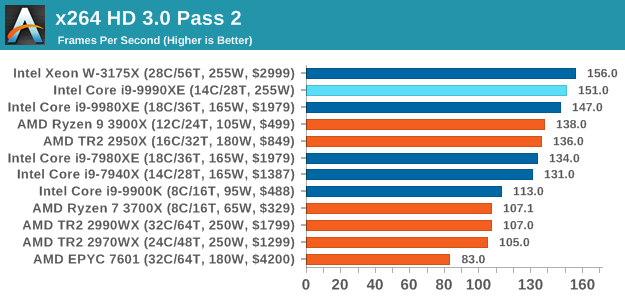










145 Comments
View All Comments
DillholeMcRib - Monday, November 4, 2019 - link
Some of you peeps seem really, REALLY bored. Do you make all these comments while at work?Retycint - Monday, October 28, 2019 - link
This is a niche CPU for an extremely niche market. That is all. Nobody (except people in that tiny niche) is looking to buy this CPU.AshlayW - Monday, October 28, 2019 - link
Sure it is, so go and buy an i3-9350K for (probably) 1% the price, and have the same single-threaded performance. If you want 14-cores, you're likely going to be doing multi-threaded work, you get my drift?This product has a small niche where you work on both types, and somehow need the 5-10% more ST perf the 9990XE has, over, say the 3950X which will boost to 4.7 on a single core at vastly (and this is a huuuge under-statement) lower power draw and price.
Proponents of Intel claim that Single-threaded speed is so important (because, hey, that 5% is all they have these days) but don't seem to understand that Zen2 has absolutely fantastic single-threaded performance. Within 10% of Intel's best, thanks to slightly higher IPC, and the clock speeds on 1T boost get up there in the high 4 GHz area, too.
vanilla_gorilla - Monday, October 28, 2019 - link
>(because, hey, that 5% is all they have these days)And it's 5% on single threaded tasks that are instantaneous on our desktop PC. I don't have any desire to have 5% more performance there. What I want is the +30-50% performance on multithreaded tasks that have real, wall clock times that can be improved, which is what Ryzen delivers. Who cares if an Intel CPU has 5% better javascript when everything I do in my web browser is instantaneous? So instead of 15ms its 13ms? Ok? What blows my mind is when my kernel compiles or video encoding times are shaved off by MINUTES.
Retycint - Monday, October 28, 2019 - link
I love how people are turning this into Intel vs AMD, even when this is an extremely niche CPU for an extremely niche market.>Who cares if an Intel CPU has 5% better JavaScript?
Well apparently people who buy these care. You are irrelevant to the discussion because you were never part of the target market for this anyway
HollyDOL - Tuesday, October 29, 2019 - link
In scenarios where 'winner takes it all' those 5% are more than enough. Previously I worked on algorithmic trading and there it would be worth every cent.ET - Monday, October 28, 2019 - link
> Against AMD counterparts, that 5.0 GHz frequency carves through anything like butter.From the benchmarks, it lost to the 12 cores 3900X on more than one occasion. While it's true that for specific workloads the 9990XE would be much better, on average it seems to definitely not be worth the price. Also, comparisons to Zen 2 EPYC CPUs (or Threadrippers, which will soon be released) would be much more apt.
chris.london - Monday, October 28, 2019 - link
I was thinking the same. Even if I don’t take the power draw into account I am not impressed at all. And at 600W I would expect this to destroy the 3900X, so these results are actually quite embarrassing for Intel. I personally would rather wait for a 16 core Zen 3 AND pay for it than have this one for free.Retycint - Monday, October 28, 2019 - link
Well I'll gladly take this one for free... Infinite perf-to-price ratio (x performance over $0 price)GreenReaper - Tuesday, October 29, 2019 - link
You may however have to factor in a new motherboard, and new cooling as well.